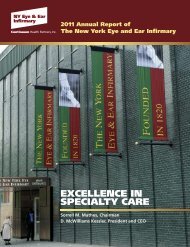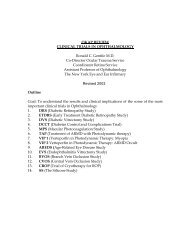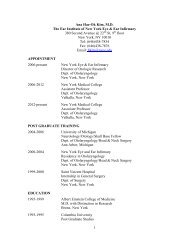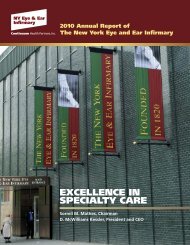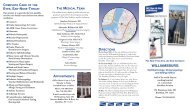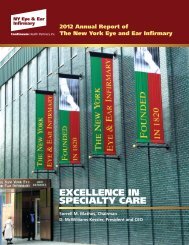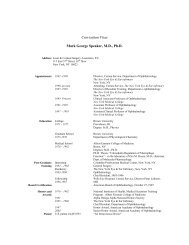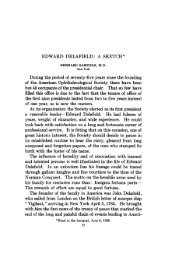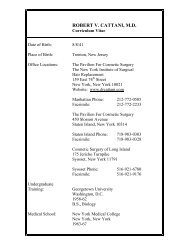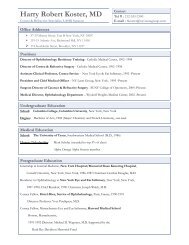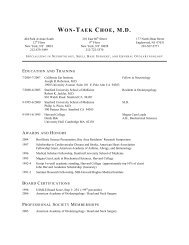The Impact on Glaucoma from the OUTSIDE IN - New York Eye and ...
The Impact on Glaucoma from the OUTSIDE IN - New York Eye and ...
The Impact on Glaucoma from the OUTSIDE IN - New York Eye and ...
Create successful ePaper yourself
Turn your PDF publications into a flip-book with our unique Google optimized e-Paper software.
Recently, 4 glaucoma specialists <strong>and</strong> 1 cornea specialist<br />
c<strong>on</strong>vened to discuss <strong>the</strong> evidence-based literature <strong>and</strong> <strong>the</strong>ir<br />
insights relevant to <strong>the</strong> intersecti<strong>on</strong> of ocular surface health<br />
<strong>and</strong> IOP management. This CME activity summarizes<br />
highlights <strong>from</strong> <strong>the</strong> discussi<strong>on</strong> <strong>and</strong> shares <strong>the</strong> faculty’s<br />
expertise regarding <strong>the</strong> prevalence of OSD in patients with<br />
glaucoma or ocular hypertensi<strong>on</strong>, <strong>the</strong> effects of preservatives<br />
in ocular antihypertensives <strong>on</strong> <strong>the</strong> ocular surface, <strong>and</strong><br />
<strong>the</strong>rapeutic approaches to improve patient outcomes.<br />
<strong>IN</strong>TRODUCTION<br />
Historically, <strong>the</strong> health of <strong>the</strong> ocular surface in patients with<br />
glaucoma or ocular hypertensi<strong>on</strong> has been overlooked <strong>and</strong><br />
underappreciated by both comprehensive ophthalmologists<br />
<strong>and</strong> glaucoma specialists. <strong>Eye</strong> care clinicians have focused<br />
<strong>on</strong> <strong>the</strong> reducti<strong>on</strong> of intraocular pressure (IOP), <strong>and</strong> often<br />
have not c<strong>on</strong>sidered <strong>the</strong> c<strong>on</strong>sequences of patients’ red,<br />
weepy, <strong>and</strong> uncomfortable eyes. Poor ocular surface health<br />
has been c<strong>on</strong>sidered <strong>the</strong> price to pay for c<strong>on</strong>trol of IOP.<br />
Recently, eye care clinicians have recognized <strong>the</strong> importance<br />
of maintaining ocular surface health when managing IOP.<br />
Studies show that approximately 50% of patients with<br />
glaucoma or ocular hypertensi<strong>on</strong> treated with ocular<br />
antihypertensives have symptoms c<strong>on</strong>sistent with ocular<br />
surface disease (OSD). 1,2,3 Moreover, <strong>the</strong> evidence indicates<br />
that <strong>the</strong>re is a direct correlati<strong>on</strong> between <strong>the</strong> number of<br />
instilled drops <strong>and</strong> <strong>the</strong> severity of OSD symptoms. 1,2,3<br />
Fortunately, <strong>the</strong> l<strong>and</strong>scape of IOP-lowering medicati<strong>on</strong>s has<br />
changed to include products that are kinder to <strong>and</strong> gentler <strong>on</strong><br />
<strong>the</strong> ocular surface. Patients may no l<strong>on</strong>ger need to trade a<br />
healthy ocular surface for c<strong>on</strong>trol of IOP.<br />
—Richard K. Parrish II, MD<br />
EYE CARE CL<strong>IN</strong>ICIANS’ OBSERVATIONS<br />
OF OCULAR SURFACE DISEASE<br />
<strong>IN</strong> PATIENTS WITH GLAUCOMA<br />
OR OCULAR HYPERTENSION<br />
Dr Parrish: Dr Pflugfelder, as a cornea <strong>and</strong> external eye disease<br />
specialist, what are typical findings of OSD in patients with<br />
glaucoma or ocular hypertensi<strong>on</strong>?<br />
Dr Pflugfelder: <str<strong>on</strong>g>The</str<strong>on</strong>g>re is no universal presentati<strong>on</strong>; however,<br />
patients often complain of ocular discomfort, particularly <strong>from</strong><br />
<strong>the</strong> administrati<strong>on</strong> of ocular medicati<strong>on</strong>s. Signs of OSD include<br />
redness of <strong>the</strong> eye, pathology of <strong>the</strong> corneal epi<strong>the</strong>lium, <strong>and</strong><br />
severe posterior lid margin disease.<br />
Dr Parrish: Dr. Moster, do you see OSD in a specific patient<br />
populati<strong>on</strong>?<br />
for cosmetic purposes <strong>and</strong> for successful treatment, including<br />
medical <strong>the</strong>rapy <strong>and</strong> surgical opti<strong>on</strong>s.<br />
Dr Parrish: Dr Lewis, with <strong>the</strong> patent expirati<strong>on</strong> of br<strong>and</strong>ed<br />
Xalatan ® , generic latanoprost is now available <strong>from</strong> many<br />
different manufacturers. In your practice, have you noted<br />
increased ocular surface complaints <strong>from</strong> patients who<br />
switched <strong>from</strong> <strong>the</strong> br<strong>and</strong>ed Xalatan ® to generic latanoprost?<br />
Dr Lewis: This is a bewildering issue. Each time a patient’s<br />
generic latanoprost prescripti<strong>on</strong> is refilled, he or she may<br />
receive <strong>the</strong> medicati<strong>on</strong> <strong>from</strong> a different manufacturer. In my<br />
experience, this variati<strong>on</strong> in manufacturers has been<br />
associated with inc<strong>on</strong>sistency in terms of both efficacy <strong>and</strong><br />
ocular redness.<br />
Dr Moster: I agree with Dr Lewis. Although all formulati<strong>on</strong>s of<br />
generic latanoprost should be equivalent, <strong>the</strong>re may be slight<br />
differences in <strong>the</strong> compositi<strong>on</strong> of <strong>the</strong> preservative or additi<strong>on</strong>al<br />
ingredients that may cause increased ocular surface changes.<br />
Dr Hernd<strong>on</strong>: Generic medicati<strong>on</strong>s provide an affordable<br />
<strong>the</strong>rapeutic opti<strong>on</strong> for my patients. In my practice, I have<br />
observed <strong>on</strong>ly a few circumstances in which a generic alternative<br />
has failed to uphold <strong>the</strong> efficacy of its br<strong>and</strong>-name equivalent.<br />
IMPLICATIONS OF POOR OCULAR<br />
SURFACE HEALTH <strong>IN</strong> PATIENTS WITH<br />
GLAUCOMA OR OCULAR HYPERTENSION<br />
Dr Parrish: Let us discuss <strong>the</strong> clinical implicati<strong>on</strong>s of poor<br />
ocular surface health in patients with glaucoma or ocular<br />
hypertensi<strong>on</strong>. <str<strong>on</strong>g>The</str<strong>on</strong>g> first c<strong>on</strong>siderati<strong>on</strong> relates to <strong>the</strong> practical<br />
c<strong>on</strong>sequence of patient n<strong>on</strong>adherence to a medical regimen<br />
that causes adverse effects. Our colleagues James C. Tsai,<br />
MD, <strong>and</strong> Gail F. Schwartz, MD, have reported <strong>on</strong> <strong>the</strong> obstacles<br />
to patient adherence to ocular medical <strong>the</strong>rapy caused by<br />
deleterious effects <strong>on</strong> <strong>the</strong> ocular surface. 5,6 Dr Pflugfelder, do<br />
you see suboptimal adherence to <strong>the</strong>rapy as a c<strong>on</strong>sequence of<br />
<strong>the</strong> deteriorating health of <strong>the</strong> ocular surface in patients <strong>on</strong><br />
ocular antihypertensives?<br />
Dr Pflugfelder: Yes, I receive complaints <strong>from</strong> patients who are<br />
intolerant of <strong>the</strong>ir ocular antihypertensives, <strong>and</strong> poor adherence<br />
is <strong>the</strong> outcome. Patients disc<strong>on</strong>tinue ocular agents because of<br />
blurred <strong>and</strong> fluctuating visi<strong>on</strong> due to unstable tear film <strong>and</strong><br />
corneal epi<strong>the</strong>liopathy.<br />
Dr Moster: Patients also disc<strong>on</strong>tinue <strong>the</strong>rapy because of <strong>the</strong><br />
unbearable symptoms <strong>the</strong>y experience. We have all seen<br />
patients who present with poorly c<strong>on</strong>trolled IOP, incredibly red<br />
irritated eyes, with superficial punctate keratitis, <strong>and</strong> poor<br />
corneal tear film. (Figure 1)<br />
Dr Moster: <str<strong>on</strong>g>The</str<strong>on</strong>g> prevalence of symptomatic OSD appears to be<br />
highest in adults aged 65 years <strong>and</strong> older. 4 Additi<strong>on</strong>ally, older<br />
adults are comm<strong>on</strong>ly bo<strong>the</strong>red by symptoms of OSD <strong>and</strong> often<br />
complain of difficulty using <strong>the</strong>ir medicati<strong>on</strong>s because of ocular<br />
irritati<strong>on</strong>.<br />
Dr Parrish: Dr Hernd<strong>on</strong>, you practice at a referral center <strong>and</strong><br />
see glaucoma patients who have OSD. What are your thoughts<br />
with respect to ocular surface health in patients with<br />
glaucoma?<br />
Dr Hernd<strong>on</strong>: I have become wiser to <strong>the</strong> importance of creating<br />
a kinder <strong>and</strong> gentler envir<strong>on</strong>ment for <strong>the</strong> ocular surface, both<br />
Figure 1. Red <strong>and</strong> inflamed eye with a cornea that has almost c<strong>on</strong>fluent<br />
superficial punctate staining. <str<strong>on</strong>g>The</str<strong>on</strong>g> patient presented with an IOP of<br />
36 mm Hg <strong>and</strong> a failed bleb; she was put back <strong>on</strong> a topical ocular<br />
antihypertensive.<br />
Photo Courtesy of Marlene R. Moster, MD<br />
3



